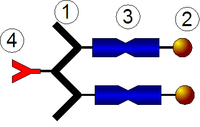
Photo from wikipedia
Proteinosome, characterized by an inner aqueous cavity wrapped by membrane with embedded protein, is one of the most attractive structures, has huge potential applications on drug delivery, tissue engineering, catalysis,… Click to show full abstract
Proteinosome, characterized by an inner aqueous cavity wrapped by membrane with embedded protein, is one of the most attractive structures, has huge potential applications on drug delivery, tissue engineering, catalysis, synthetic biology, artificial cells, engineering of the biomachines, biosensors, and biodevices, etc. Here, inspired by polyphenol chemistry, a facile and universal method is presented to fabricate the diverse proteinosomes, with independence on the amino acid sequence, isoelectric points, molecular weight (Mw), wettability, and functional domains of applied proteins. Besides, the materials employed here are green and cost‐effective, and the method developed here is efficient and easily operated without any expensive equipments. The proteinosomes and the mechanism of generating proteinosomes are well characterized and analyzed by various techniques. The permeability of generated proteinosomes is underlined, which not only shows dependence on the applied proteins but also the Mw of diffused molecules. In addition, the permeability can be reversibly switched on/off in 100% by environmental pH. Capitalizing the facility and university of this method, it is believed it paves the way of the proteinosomes to multiple potential applications, such as drug delivery, micro‐/nanoreactors, tissue engineering, catalysis, biosensor, etc.
Journal Title: Advanced Materials Interfaces
Year Published: 2020
Link to full text (if available)
Share on Social Media: Sign Up to like & get
recommendations!